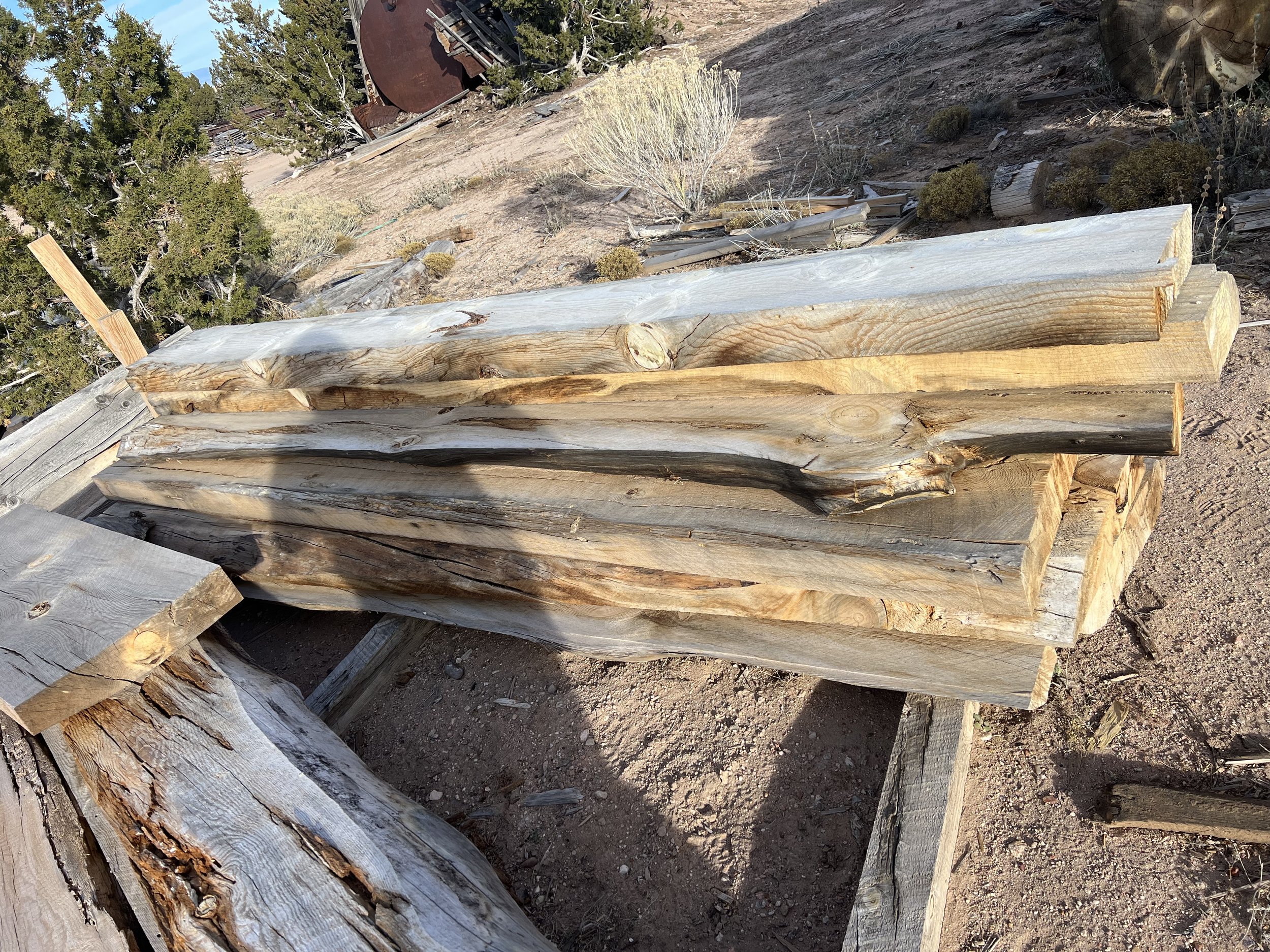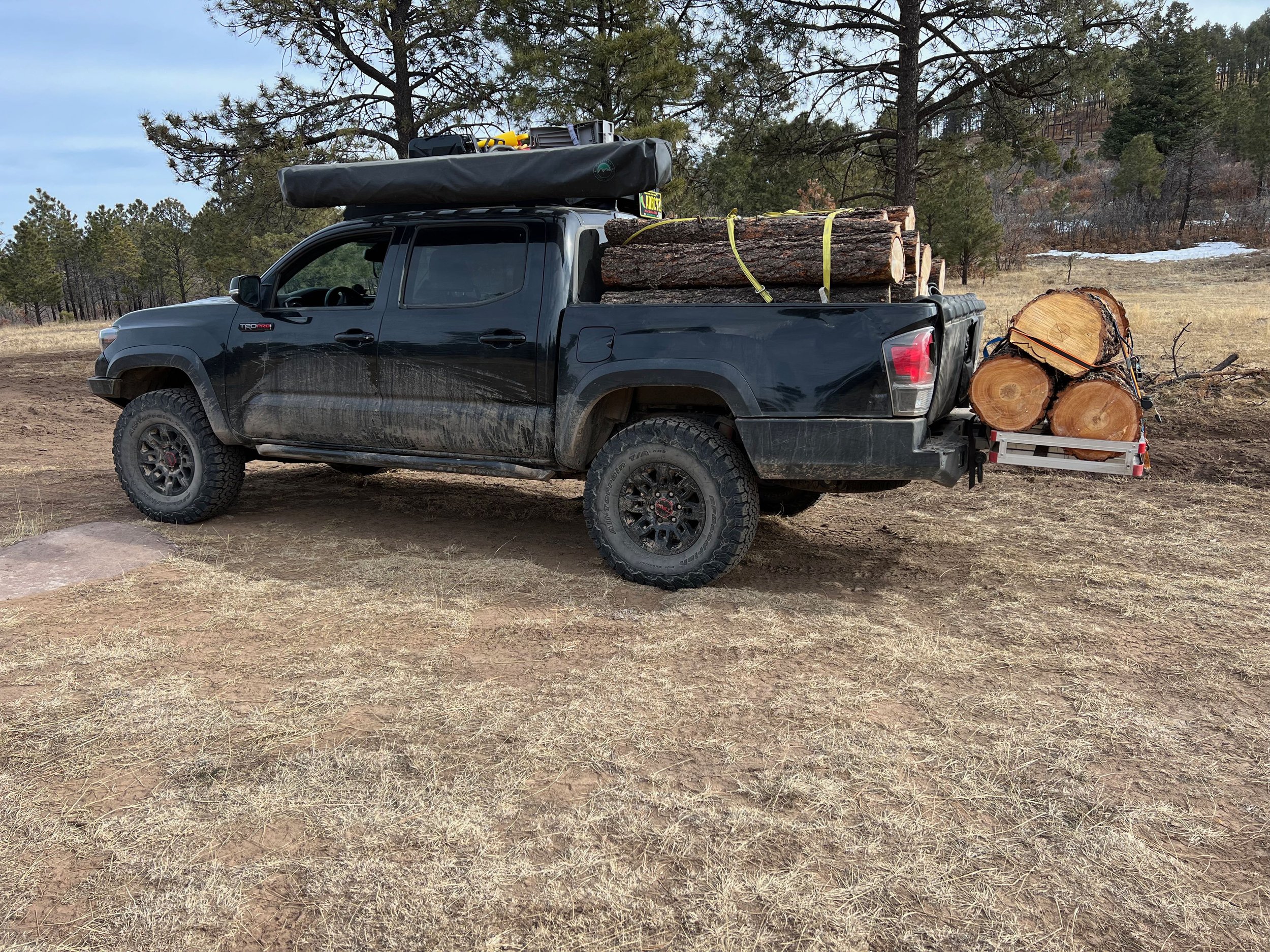
Our Process
From forest to home
Northern New Mexico’s most common trees are Douglas Fir, Engelmann Spruce, Pinion Pine, Ponderosa Pine, Quaking aspen, Subalpine Fir, and the White Fir.
Norther New Mexico is a high desert and mountainous region which facilitates the growth of mostly coniferous trees. Coniferous trees do not drop their leaves in the winter and are considered a softwood while deciduous trees drop their leaves in winter and are considered hardwoods.
Within coniferous trees common types are Fir, Pine, and Spruce these generally have similar characteristics for building, with straight grains, good workability and generally light weight. They all have needle like leaves but with distinctions, spruce needles are attached singularly to the twig and are sharp while fir needles are also attached singularly they are flat flexible and not sharp. Pine needles are attached in clusters to the twig with different amounts of needles per cluster determining species.
The hardness of wood is rated on the Janka hardness scale which is determined by the PSI required to push a steel ball halfway into a wood plank. So while Aspen is considered a hardwood because it is a deciduous tree it’s Janka hardness number is ~350f while Douglas fir a softwood has a hardness rating of 620-710f.
So while aspen is a hardwood it is actually very soft. Another unique characteristic of aspen is that it does not splinter. making with useful for building things such as toys and items that will be handled frequently.
We use a variety of wood based on their specific characteristics for its intended application. We love to use wood that would otherwise be wasted. We work with the forest service to obtain trees that are culled from the forest for fire mitigation producing our own lumber. At the same time we also have a local lumber supplier to obtain the perfect lumber for the intended application.
We can also work with you to use a specific tree. While growing up there were two big maple trees that I would climb regularly, those trees are special to me and in the next few years one is going to need to be harvested. I plan to use the lumber for many beautiful projects.
When deciding on your project we can add specific lumber or create something unique from or for your property.

THE BUILD
One of the most interesting and complex things about furniture and wood working is the build. There can be two functionally identical pieces of furniture that have completely different build qualities. Furniture builders will look at a table and see the slight variations in build quality that the average person would never notice. These differences may be important to one person but mean nothing to another. A table can be hand crafted with no metal hardware, intricate hand cut inlay out of exotic woods or it can be screwed together with common lumber and use gas pipe (commonly known as black pipe) for legs. They both serve the same function, as a surface to place things on. There is however a significant difference in the time and effort required to produce the two products. There are some other factors that differentiate the two also, usually longevity, depending on the exact construction. Wood is a natural product and as such has flaws, blemishes and character. Wood is also an active product it absorbs moisture and will move based on the relative humidity and moisture levels. This needs to be considered during the planning and construction of any wood item. If not considered properly wood and split and crack over time.
When designing and planning your project we can work with you to determine the best build type to fit your budget and lifestyle. If interested we can go through multiple different design and construction options or we can handle the details for you.
When a tree is milled there are multiple ways it can be cut. These different cuts determine the final price of the lumber but also its properties.
A round tree sliced into flat boards is called plain sawn. This orients the growth rings in a curve across the end of the board for some boards while other boards will have the growth rings at a 90* angle. This is important due to the moisture absorption and the wood movement. With the varying densities in the wood the wood will move more along the growth rings and will cup, twist or bow. While growth rings oriented perpendicular to the face of the board will remain more stable with less movement. This is important to ensue longevity of the furniture.
We either cut or own lumber or hand pick each piece to ensure strong stable furniture.

THE FINISH
The finish is just as important as the build. Each piece merits careful consideration of the finish that needs to be applied to produce beautiful safe and sustainable furniture.
For our cutting boards we use pure Tung oil. Tung oil is derived from pressing the nut of the tung tree. It has been used for centuries to seal and waterproof the wood on ships. Tung oil is absorbed into the wood and hardens through polymerization sealing the wood. This is especially effective on our end grain cutting boards and butcher blocks. Producing a food safe, durable, naturally antimicrobial item.
Our toy chests are finished with Osmo Polyx a hard wax finish. A blend of natural oils and waxes it produces a natural non toxic, food safe finish that is absorbed into the wood. It is approved for use in children’s toys and brings out the beauty of the wood without leaving a visible film on the wood. It is easy to maintain and will not crack or peel with years of use.
Our serving trays are finished based on their intended use and composition. Epoxy serving trays are flood coated with epoxy giving them an easy to clean durable surface. While our wood serving trays are finished with either Osmo Polyx or pure tung oil.
The finish for our custom items is considered for each application. Outdoor furniture is generally finished with spar urethane. Urethane finishes are built up on the exterior of the wood completely sealing the wood. Spar urethane like polyurethane is a synthetic blend of polymers that seal the wood but is also UV resistant.



